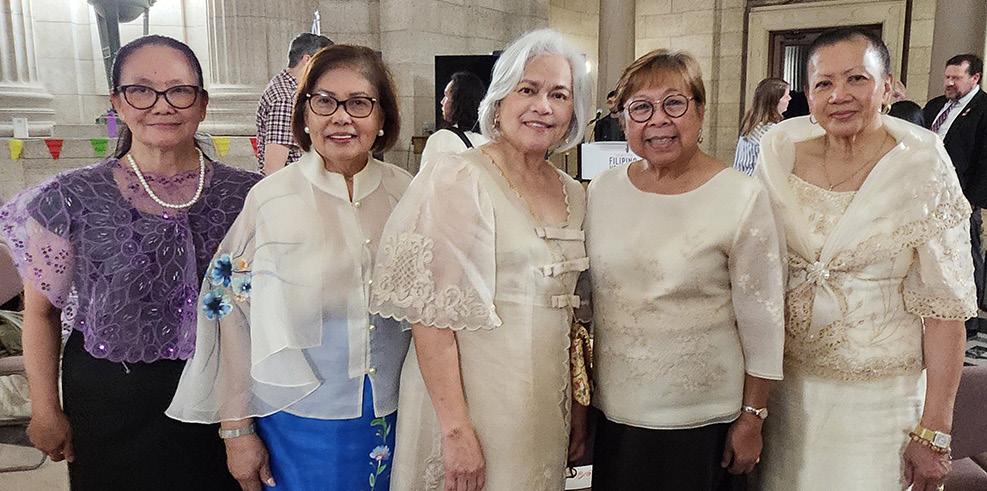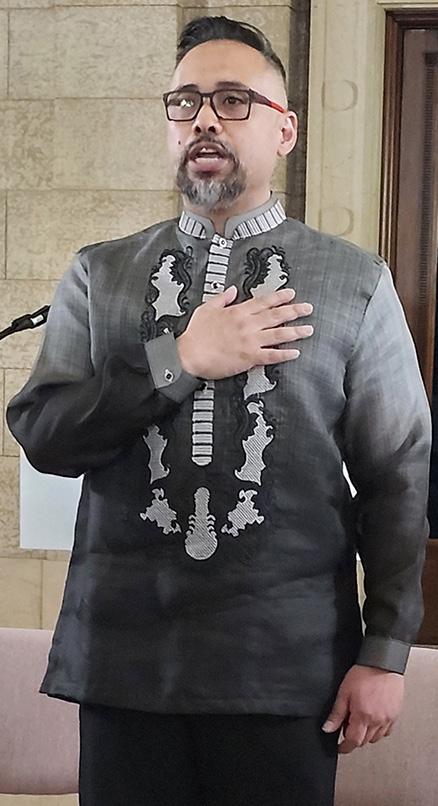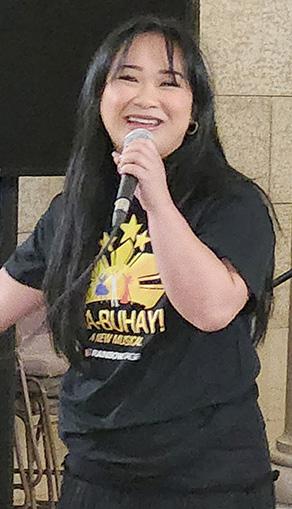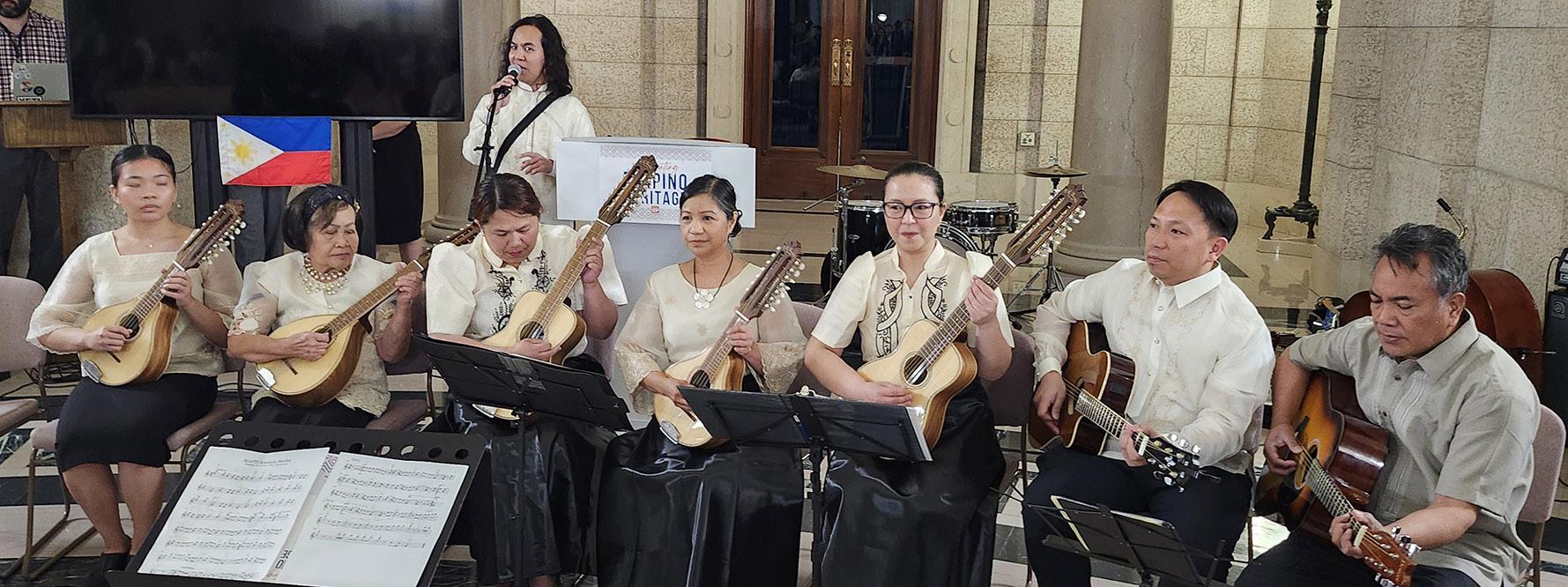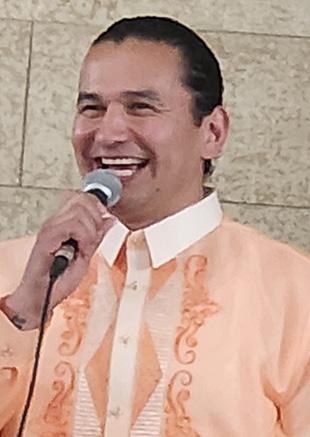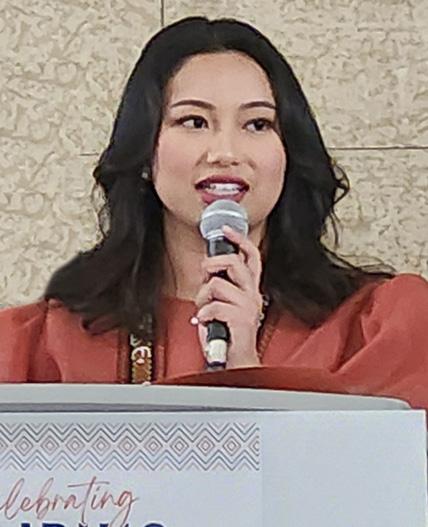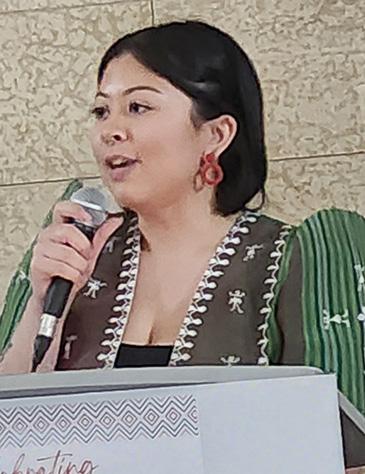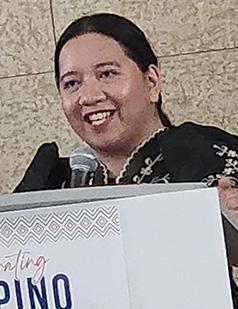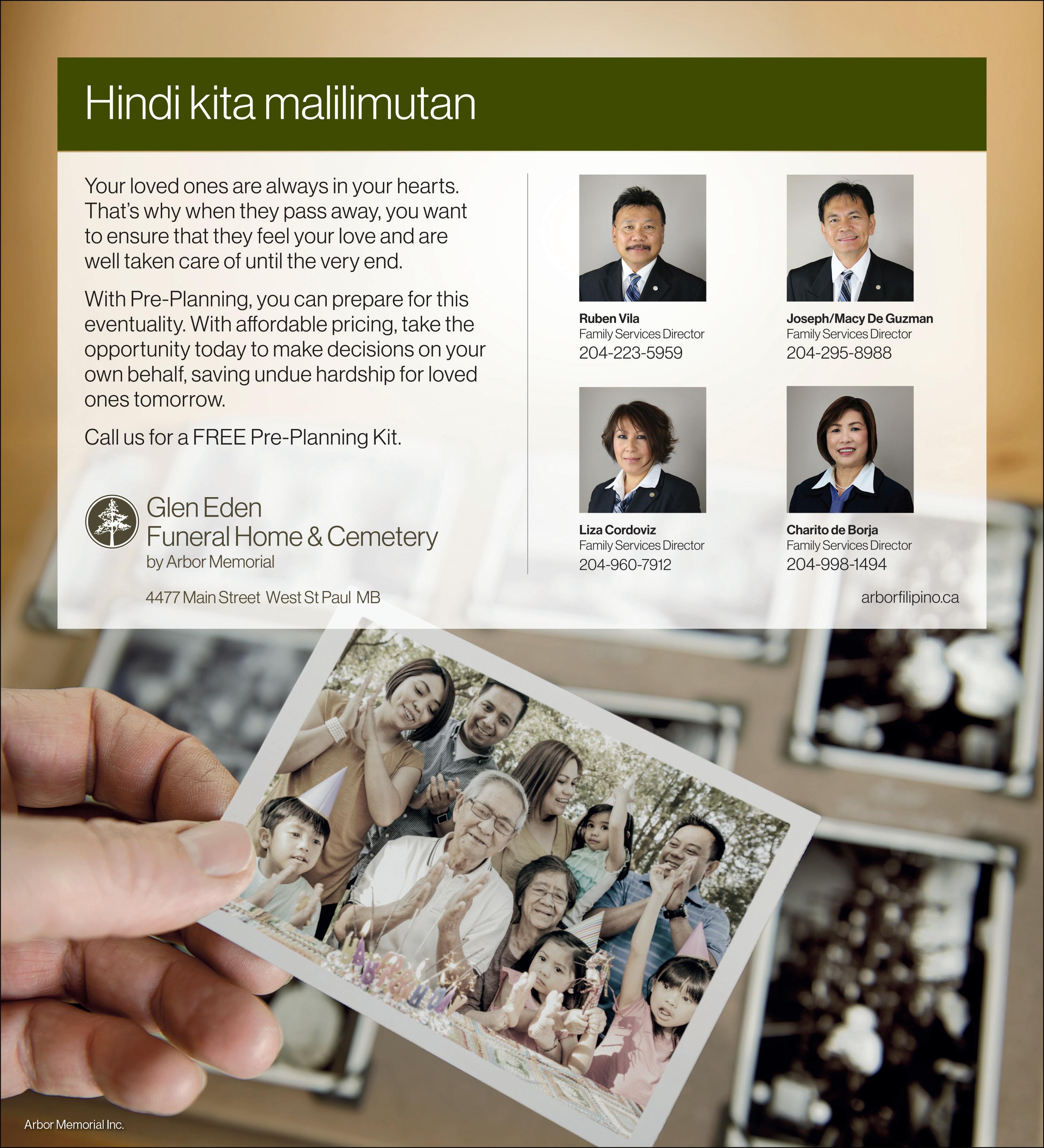

Ivana Alawi 8


Celebrating the rich tapestry of Filipino heritage

Filipino Heritage Month is celebrated every June in Canada to commemorate Philippine Independence Day on June 12 and to recognize the contributions of Filipino Canadians. In Manitoba, this celebration is marked by various programs that highlight the rich culture, traditions, and
significant contributions of the Filipino community to the province’s growth.
“The Filipino community is one of Canada’s fastestgrowing populations. With more than 900,000 people, it is the third largest Asian community in the country. Filipinos have made positive and meaningful contributions to Canada. Due to their recognized expertise in nursing and health care, they are strengthening Canada’s health care system and supporting the well-being of Canadian families. Beyond health care, Filipino


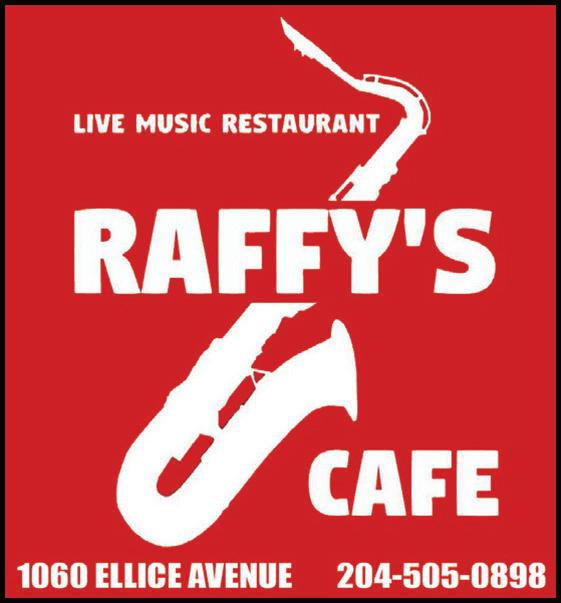










Why is this newspaper called the Pilipino Express and not the Filipino Express? For that matter, some non-Filipinos might wonder, why is not spelled “Philippino” Express, since Filipinos come from the Philippines, right?
These are fair questions if you’re not familiar with Filipino culture and history.
Spelling confusion
This uncertainty in spelling is due to the intertwined history of three languages – Spanish, English and Filipino. The country we call the Philippines today is a collection of about 7,100 islands in Southeast Asia that was once a colony of the Spanish Empire. When the Spaniards arrived in the early 1500s, there was no single nation united under one name but, rather, many autonomous chiefdoms, each with its own name and leader. The Spaniards called various parts of the archipelago by various names –New Castile, the Spanish East Indies, St. Lazarus and others, but eventually they settled on one name for all the islands – Las Islas Filipinas. This name was given to honour their Prince Philip who eventually became King Philip II. Anglos might remember him as the king who sent his Armada to attack Queen Elizabeth’s England in 1588.
Filipinas
Of course, Philip is just the English version of the Spanish name Felipe, so Filipinas was usually spelled with an F. I say “usually” because spelling was not yet standardized during the early part of the Spanish colonial period in the Philippines. Practically every possible variation of spelling can be found for the word Filipinas in books of the 1500s and 1600s –
Filippinas, Philipinas, Philippinas and even Piliphinas
Philippines
When translated into English, Las Islas Filipinas is “the Philippine Islands,” spelled with Ph to match the spelling of Philip. Sometime shortly after World War II, the “Islands” part of the name was dropped, so now we just call it the Philippines.
Filipino
The Spanish word for a person from Las Islas Filipinas was naturally Filipino, with an F. Originally this referred to a Spaniard born in the Philippines, not to an indigenous inhabitant of the islands. The people we know as Filipinos today, the Spaniards once called Indios, which is the same stupid misnomer that my ancestors gave to the original inhabitants of North America –Indians
English never had a suitable equivalent for Filipino – a “Philippine,” “Philippian” or “Philippinian” probably just didn’t sound right, so English adopted the Spanish word Filipino, retaining the letter F and the suffix, “ino.”
Pilipino
After the Spanish-American War at the end of the 1800s, the Americans held the Philippines for almost 50 years. During that time Filipinos developed a national language of their own. This language was called Pilipino It was based mainly on Tagalog, which is the language of the region around the capitol, Manila. (Some traditions say that the name Tagalog is from taga-ilog, which refers to people “from the river area.”) Pilipino was spelled with a P because there was no F sound in Tagalog or in most of the other 170 languages and dialects of
The basics of Filipino Why isn’t it spelled “Philippino?”
the islands. It is one of history’s ironic twists that the Filipinos and their country were named after a monarch whose name began with a sound that was completely foreign to their own tongues. Since the ancient Filipino script called baybayin didn’t have an F, it was not included in the official Pilipino alphabet, either. This was known as the abakada
So, the national language became, Pilipino, the people called themselves Pilipino and Pilipina, and they called their country Pilipinas. Of course, foreigners continued to use their own words for the name the country.
Back to Filipino
As time went on, the authorities in charge of developing the national language had to accept the fact that foreign words and sounds were already a part of everyday Pilipino speech. They overhauled the official alphabet in the 1970s and again in the 1980s, so it now includes foreign letters such as F Today the language is officially called Filipino, and the country is Filipinas, though Philippines is still the name used when speaking English. The official Filipino language recognizes both Filipino and Pilipino, and the feminine Filipina and Pilipina, as acceptable terms for the citizens of the Philippines.
Pinoy
The slang terms Pinoy (for men) and Pinay (for women) also arose during the 20th century. They were first used by Filipinos in the United States in the 1920s, and then later adopted in the Philippines. These words are similar to “Canuck,” for Canadians or “Yankee” for Americans, except that they don’t have the derogatory sense that outsiders sometimes apply to Canuck or Yankee.
The Filipino language
Another question I’ve heard
from time to time is, “What do Filipinos speak? It’s like Spanish, right? What’s it called? Tag-aLog?” Some people who are not familiar with Filipino culture have different ideas about what Filipinos speak. Some think it is a kind of pidgin or Creole based on Spanish while others assume it is like Chinese or Vietnamese. However, Tagalog (pronounced tah-GAH-log) and the other major languages of the Philippines are, in fact, languages in their own right. And even though Filipinos sometimes talk about their own particular “dialects,” such as Cebuano or Ilokano, these are actually distinct languages, not dialects. These languages are related to each other, and they each have their own variations or dialects.
The languages of the Philippines share a common ancestry with the languages of Malaysia and Indonesia. Many basic Malaysian words, like the numbers and the parts of the body, are so much like Philippine languages that a Tagalog person hearing Malaysian might mistake it for one of the languages of the southern Philippines. All these languages are part of the Austronesian family of languages, also known as Malayo-Polynesian, which reaches from Madagascar, just east of Africa, through the islands of Southeast Asia, all the way to Guam, Hawaii and even to Easter Island (Rapa Nui), just west of South America.
Filipino and the regional languages of the Philippines have a rich vocabulary with borrowings from many sources thanks to a long history of trade contacts with many neighbouring countries. The Chinese brought many words related to food, cooking, business and even family related terms like kuya and ate for eldest brother and eldest sister. Hindus and Muslims
from Malaysia and Indonesia brought words with roots going back to the ancient Sanskrit language of India – words related to the arts and religion, like katha, likha, and diwata (literary work, creation and goddess).
The Spaniards brought words related to Christianity, government and technology up to the 19th century. And due to their long occupation, Spanish words even displaced some basic indigenous words like bisig for arm, which is more commonly called by the Spanish-derived term braso. The word boses, from the Spanish voz, for “voice” is used more often than the Tagalog word tinig, which has since taken on a more poetic tone.
English now supplies most of the words related to modern technology, arts, and pop culture. With this mixture of accepted borrowings, various regional languages and the common use of Taglish (Tagalog/English slang), it’s no wonder that some nonFilipinos might not know how to describe what they hear when Filipinos are talking to each other.
So, to sum it all up:
• Philippines is the English name for the country, while –
• Filipinas is both the Spanish and Filipino name for the Philippines.
• The people are called Filipinos in English, Spanish, and Filipino,
• but many Filipinos still prefer to call themselves Pilipino and their country Pilipinas
• The national language is based on Tagalog but it has many words borrowed from languages near and far. For a time it was called Pilipino but now its official name in all three languages is Filipino.
Oh, and Philipino, Philippino and Phillippino? Well, those are just wrong.


Phone: 204-956-7845
E-Mail: info@pilipino-express.com
Website: www.pilipino-express.com
Publisher: THE PILIPINO EXPRESS INC.
Editor-in-Chief: EMMIE Z. JOAQUIN
Associate Editor:
MORROW
ANNE CAPRICE B. CLAROS
ETHEL CLEMENTE FERNANDEZ BRO. GERRY GAMUROT
NORMAN ACERON GARCIA
LUCILLE NOLASCO GARRIDO
MICHELE MAJUL-IBARRA
NOEL LAPUZ JON MALEK
MALAYA MARCELINO
ALONA C. MERCADO
CST. REY OLAZO DR. REY PAGTAKHAN OSCAR PANTALEON JR. CHERYL DIZON REYNANTE MICHAEL SCOTT
Philippine Correspondents:
JOAQUIN
R. OCAMPO
SALES & ADVERTISING DEPARTMENT: 204-956-7845 E-Mail: info@pilipino-express.com
Sales & Marketing Team:
RAMOS URBANO Youth Contributors Aksyon Ng Ating Kabataan (ANAK)

We are becoming more and more familiar with artificial intelligence or AI in the world of today. Immigration, Refugees and Citizenship Canada (IRCC) has not been forthcoming in terms of their use of AI in processing application submissions. We need to be aware that artificial intelligence has been used for some time by IRCC and that usage will only increase over time. The public is becoming more familiar with the application of AI through a series of Access to Information Act as well as records from the appeals submitted to the Federal Court of Canada.
It is important to know that since 2015 most visa exempt foreign nationals had to apply for an Electronic Travel Authorization (ETA) before they could travel to Canada. These applications were for the most part automated applications. The ease of submitting these applications is a tribute to automation and anyone who has applied for an ETA will attest to the ease of the application process
In 2017 IRCC successfully conducted a pilot based on automated systems of predicative outcomes to measure low-risk online submissions from China. Visa applications were sorted
into tiers, the lowest risk for auto-approval, with medium and high risk assigned to officers for review. The triage model was applied to all applications from China in 2018 and in the same year the pilot was extended to submissions from India. The goal for AI was to automatically approve low-risk applications, with officers manually assessing submissions flagged as medium to high risk.
The use of AI is now being applied to Family Class Immigration. On May 30, 2024, IRCC announced its intention to use advanced analytics and automated technology to process all spousal and partner applications under the family class. IRCC will be developing automated evaluations to increase processing efficiency. The question we need to ask is what will these changes apply to?
The departmental announcement included the use of AI in two parts. The first part of the family stream sponsorship is an examination of the Canadian sponsor. The question to be met is whether the Canadian sponsor meets eligibility requirements. The second part of the process concerns the applicant and whether they are admissible to


Artificial intelligence and Family Class sponsorships
Canada. IRCC will use automation tools to identify cases that can be automatically approved with the intention of reducing processing times. Applications that require more examination will be sent to an IRCC officer for manual review.
The IRCC model has the potential to examine all submissions at the first stage (sponsor eligibility) or second stage (applicant admissibility) or a combination of both. At either stage, challenging submissions will be assigned to an IRCC officer to be manual reviewed. AI is not intended to replace officers but to complement their assessment and reduce backlogs. The final approval on all submissions will still rest with the reviewing
immigration officer.
The expansion of AI is intended to improve processing. IRCC has affirmed its commitment to deploy “data driven technologies” in line with privacy requirements and human rights. The department assures users that they have measured the algorithmic impact assessment (AIA) of these new tools on processing. IRCC states that the anticipated impact of AIA is “moderate,” with the department committed to additional measures to soften the implementation or “mitigate possible risks.”
The former minister Sean Fraser assured immigration program users that the departmental pilot used with TRVs etc. has demonstrated the
positive aspects of AI in dealing with low-risk submissions. Minister Fraser reported that AI used for TRV applications had resulted in 98 per cent of applications being processed in just 30 days. Hopefully the same results will be realized with family class sponsorships.
Michael Scott is a Regulated Canadian Immigration Consultant (RCIC, R525678) who has 30 years of experience with Immigration Canada and the Manitoba Provincial Nominee Program. He currently works as a licensed consultant with Immigration Connexion International Ltd. Contact him at 204-691-1166 or 204-2270292. E-mail: mscott.ici@gmail. com.


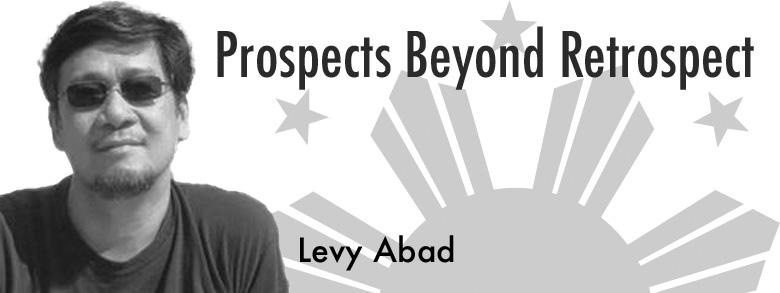
Mario Tamayo arrived in Winnipeg in 1975 from Malolos, Bulacan, a province in the Philippines that played a crucial role in the country’s history. Mario shared that he finished his tertiary education at FEATI University at the height of student activism in Manila. He recalled Bill Alcaras, a known student leader during that time. He joined some rallies and teach-ins before the declaration of Martial Law. As early as 1969, Mario worked at the Manila Electric Company (Meralco).
According to Mario’s daughter Paige Dimayuga, before moving to Winnipeg, her father worked at Delta Motors Toyota branch in Manila around 1972. He was also an active founding board member of its union when he was 21.
Faithful to union principles
Mario arrived in Winnipeg three years after the declaration of Martial Law, a period that characterized the heightened struggle of the Filipino working class against the fascist inroad of neoliberalism in the Philippines. This dark period was fought fiercely by the Filipino workingclass movement that gave birth to the Kilusang Mayo Uno (KMU) on May 1, 1981(Manggagawa: Noon at Ngayon).
Upon his arrival in Winnipeg, Mario got a job at MacDon Industries Ltd., “a Canadian manufacturer of specialty agricultural equipment established
by Joe MacDonald of Truro, Nova Scotia in 1970.” (Wikipedia)
He worked as a sheet metal machine operator. Faithful to his union principles, Mario became a member of the local workers association for three years.
After three years at MacDon, he moved to Bristol Aerospace (now Magellan Aerospace) as an aircraft sheet metal mechanic. It was here where Mario became a union member of CAW Local 3005 and a shop steward for 30 years. He also headed the human rights desk and became a part of the collective negotiations committee of the local. In a phone interview on May 25, 2024, Mario told me that on several occasions their CAW Local launched strikes to assert workers’ rights and welfare. He stressed that the strike is an instrument of last resort for the workers, used only when dialogue fails.
According to union brothers According to Neri Dimacali, a pioneer Boeing CAW Local 2169 Vice-Chair and community organizer, Mario helped a lot whenever a trade union leader from Manila arrived in Winnipeg in the mid-90s and onwards.
Among them were Elmer Labog, Kilusang Mayo-Uno Vice-Chair who visited in 1997 and 2006, and Crispin Beltran, Kilusang MayoUno Chair in 2008, who came for a solidarity mission – exposing the impunity of the Gloria Macapagal
Mario Tamayo: Unionism from Manila to Winnipeg
Arroyo regime’s gruesome human rights record. Mario hosted the Philippine trade union reps of KMU on these solidarity occasions.
During my interview in May 2024 with Eddie Miller, a former Philippine movie star and CAW Local 2224 trustee and organizer, Eddie recalled that Mario attended a Family Education Program at Port Elgin, Ontario where the CAW education institution is located. It was also here that both took a course in organizing. On the other hand, Mario shared that his instructors at Port Elgin were Hassan Yusuff (who later became the Chair of the Canadian Labour Congress) and Bob White, founding president of CAW.
Community and church activism
It was around 2011 to 2013 when I was a member of Migrante-Manitoba, a migrant advocacy group advancing the rights and welfare of Filipino migrants in Canada, when I met Mario. I appreciated his profound interest in social issues that affect migrant workers and his concern for the Philippine struggles. He told me that it was during that time when he sang at St. Joseph the Worker Church in Transcona as a member of its music ministry. Mario’s church involvement and concern for the Filipino migrant workers reminded me of the encyclicals of the Catholic Church like Laborem Exercens, Matter et Magestra, Gaudium et Spes, and Pope Francis’ Fratelli Tutti. All these church documents call on
the laity to work for justice, peace, and compassion for migrants.
Mario is still working at Magellan (formerly Bristol). He is one of the pioneer labour leaders of Winnipeg. Knowing the sacrifices that a union leader goes through, it is befitting to include him in the narrative of labour leaders, thus putting on record his humble contribution to the Filipino community’s early years in Winnipeg.
Levy Abad authored a book titled Rhythms and Resistance: Narrative of Filipino Musicians and Activists (1972-1994). Levy is also a singer-songwriter, poet, and migrant rights activist who has released four albums centred on the life and struggles of migrants.

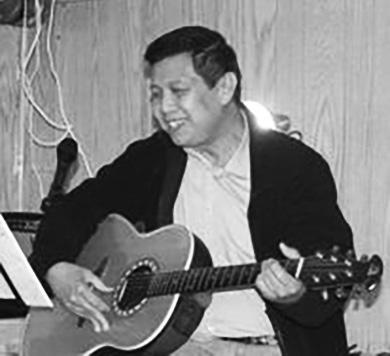
Kundiman, Harana, y Zarzuela in Manitoba
by Ronald Mervin SisonIn celebration of Filipino Heritage Month, on June 6, 2024, for the first time in its history, the hallowed halls of the Manitoba Legislative Building echoed with the sounds of timeless kundiman, harana and zarzuela songs sung in the classical tradition. The intimate performance featured three classical singers – Mexican soprano Paulina Gonzalez, soprano Jasmine Wallace, and tenor Ronald Mervin Sison; maestro Jett Russel Panganiban on piano, and emerging young singer Summer Flora Santos.
The program began with a welcome by Minister Malaya Marcelino, the land acknowledgement let by City Councilor Vivian Santos, and the Filipino and Canadian national anthems sung by Summer Flora Santos.

The repertoire featured compositions by Abelardo, Santiago, de Guzman, Suarez, Silos, and Cuenco; zarzuela by Chapi and Obradors, and Puccini. Many famous pieces were performed, including Nasaan Ka Irog, Bayan Ko, Madaling Araw, Katakataka, Dahil Sa Isang Bulaklak and Gaano Ko Ikaw Kamahal. The KUNDIMAN or “kunghindi-man” translated to “if it can’t be”; and the HARANA or “serenade” are the foremost classical music traditions of the Philippines. The harana is inspired by 333-years-old Spanish colonial courtship tradition and the kundiman emerged in the late 1800s and early 1900s during the American period as an expression of nationalism and undying love. The lyrics are poetic, artistic, and mostly in Tagalog, but can also be in other Philippine languages, and their composers studied and wrote music inspired by their love of country and by the musical masters of their times.



SHOWBIZ SHOWBUZZ
Ivana Alawi’s biggest lesson as content creator:
‘I don’t read comments’
Ivana Alawi admitted that she used to fire back against bashers. Among the words thrown at her include “hubadera lang” and “puro retoke.”
“Dati talaga nagbabasa ako ng [comments] pero ‘yung manager ko tinuruan ako na don’t read, deadma na,” Alawi said.
Saying that bashers don’t affect her now, she added: “Hindi mo naman talaga maple-please lahat ng tao. That’s something that you should always keep in mind na may mga taong magugustuhan ito, may mga taong hindi.”
“Pero tuluy-tuloy lang ako. I don’t read comments na. Kung hindi nila gusto, salamat pa rin. Kasi kung papa-control ako sa kanila, anong maiisip kong content?”
During the Perfume Dessert event in Makati City, the internet sensation also talked about her process as a vlogger and the most expensive thing she got for herself – a watch.
“Wala kaming script. Usually kapag may content or may pinost ako, I always make sure na authentic ‘yung pino-post ko. Ang importante sa akin ay walang script. Just be yourself. Tuluy-tuloy naman siya kung anong maisip ko,” she said.
For Alawi, YouTube is an outlet to express herself and to show people her everyday life — unfiltered.
As one of the most followed celebrities on YouTube with 17.9 million subscribers, Alawi shared

this piece of advice: “Be yourself. Believe in yourself. When it’s your time to shine, you will shine. Kunwari nag-start ka na and it’s not working, don’t give up kasi darating din ‘yung time mo.”
Despite her success as a content creator, Alawi admitted that she still feels nervous every time she does her vlog, or when she pranks strangers on the street.
“Kapag nagpra-prank ako sa kalye, kinakabahan talaga ako kasi anything can happen. Puwede akong sapakin,” she said. “Kabado talaga ako every time na
See IVANA p13

PulangAraw debuts early on Netflix GMAdropstrailerofthegroundbreakingseries
GMA Network’s highly anticipated drama, Pulang Araw, is set to premiere on Netflix this July 26.
In a first for the Network, the series will be available on the streaming platform 72 hours ahead of its scheduled local airing on GMA on July 29.
Headlining this groundbreaking series are some of
the biggest Kapuso stars: Barbie Forteza as Adelina, Sanya Lopez as Teresita, David Licauco as Hiroshi, and Alden Richards as Eduardo, with the special participation of Dennis Trillo as Col. Yuta Saito.
Pulang Araw traces the intertwined lives of four childhood friends – Eduardo, Teresita, Adelina, and Hiroshi.
As war ravages their homeland and Japanese forces occupy the country, their dreams, friendships, and loyalties are tested, leading them on a journey of selfdiscovery and resilience.
Their war stories will inspire and impact the lives of Filipinos today who persevere and remain hopeful despite extreme See ARAW p13

Arnold Clavio, ibinahagi ang naranasang health scare nang magka-hemorrhagic stroke
Arnold Clavio, ibinahagi ang naranasang health scare nang magka-hemorrhagic stroke
Ibinahagi ni “Igan” Arnold Clavio ang naranasan niyang health scare kamakailan, na una niyang naramdaman habang nagmamaneho ng sasakyan.
Sa kaniyang Instagram post, sinabi ni Arnold na papauwi na siya galing sa paglalaro ng golf noong June 11 nang may kakaiba siyang naramdaman sa kanang bahagi ng kaniyang katawan na “matinding pamamanhid sa kanang braso at binti.”
“‘Di ko na rin maramdaman ang pag-apak sa pedal ng gas at brake,” patuloy niya.
Sandali umano siyang tumigil

sa isang gas station para suriin ang kaniyang sarili.
“Papunta ng restroom, hindi na ako makalakad. Kailangan ko na may mahawakan,” sabi pa ni Igan.
Tiningnan niya kung lumaylay ang kaniyang mukha o may pamamaga sa kaniyang mata, na palatandaan ng stroke, batay sa
Medical News Today. Nang wala siyang nakita sa mukha, muling sumakay ng kotse si Igan para pumunta sa pinakamalapit na ospital.
Pero ayon Kapuso broadcast journalist, hindi naging madali sa kaniyang kondisyon ang See ARNOLD p13


Chelsea Manalo meets Gloria Diaz
Miss Universe Philippines
2024 Chelsea Manalo and Miss Universe 1969 Gloria Diaz officially met each other at the 126th Independence Day celebration at the Quirino Grandstand in Manila.
In an Instagram Reel posted by Miss Universe Philippines, the two beauty queens could be seen in stunning Filipiniana dresses.
Chelsea and Gloria held hands and spoke to each other with big smiles.
Fans in the comments section are loving their meet-up. An Instagram user said it best:
“Meeting the first and the next Pinay Miss Universe!!”
Chelsea, a beauty queen from Bulacan, was crowned the new Miss Universe Philippines in May. She will compete at the upcoming international pageant in Mexico.
Previously, the Filipina beauty queen held a homecoming event in her hometown and her alma mater, De La Salle Araneta University.
Recently, Chelsea officially named her pasarela the Tampisaw Walk and was a stunner in her Miss Universe Philippines portraits. – GMA Integrated News

Chelsea Manalo and Gloria Diaz


SHOWBIZ SHOWBUZZ
Willie naiyak nang mamaalam sa Wowowin
Sa isang sorpresang Facebook Live, inanunsyo ni Willie Revillame ang title ng magiging comeback show niya sa TV5, iyan ay ang Wil to Win.
Ang rebranding ng kaniyang social media pages mula “Wowowin” patungong Wil to Win ay tanda ng kaniyang pakikipagsanib-puwersa sa MQuest Ventures, Inc.
Makikita sa mismong bagong logo ng kaniyang programa na handang-handa na si Kuya Wil na maghatid ng mga sorpresa at papremyo sa sambayanang Filipino.
At bilang paghahanda sa pagbubukas ng bagong programa, pangungunahan ni Kuya Wil ang isang Grand WINference – isang interactive telethon sa June 20 kung saan mabibigyan ng chance ang
mga fans at members ng media na magtanong kung ano nga ba ang kanilang dapat abangan sa bagong programa.
Mapapanood ang Grand WINference sa mga opisyal na social media account ng Wil to Win at TV5.
Sa ngayon ay wala pang ina-announce kung kailan ang eksaktong petsa ng pagsisimula sa ere ng Wil to Win.
“Magsisimula po ang programa ng araw ng Linggo. Kung anong date po, abangan ninyo. Alam ninyo kung bakit, it’s family day. Yung Linggong yon, makakasama namin kayo.
“Pagkatapos ng Linggo, tuluytuloy na po. Magmula Lunes hanggang Biyernes, kasama ninyo na po ang bagong programa dito
yan sa TV5,” aniya.
Hindi naman napigilan ng TV host ang maluha nang magpaalam na siya sa Wowowin na halos pitong taong napanood sa GMA 7 at pagkatapos mapanood ang music video ng kanta niyang “Salamat Sa Inyo.”
“Maraming mga pagsubok, maraming nangyari. May luha ng kaligayahan, may luha ng hinagpis.
“Sorry ho naging emosyonal ako dahil mawawala na ho kasi si Wowowin…for six and a half years, sinamahan ninyo ako araw-araw sa GMA 7. Sa totoo lang, wala na akong TV show. araw-araw na sinasabi sa akin na wala ni isang umalis sa Facebook at sa YouTube. Naghihintay, nandiyan sila,” pahayag pa ni Kuya Wil.
– Ervin Santiago, Bandera




OUR COMMUNITY
Philippine Independence Day celebration at Meadows West School
Meadows West is an inclusive and diverse school that embraces and celebrates all cultures. The Filipino community represents a large number of our students and staff. Our school is the home of the Filipino Bilingual Program in the Winnipeg School Division. The Filipino Bilingual Program provides opportunities for students to learn about Filipino language, heritage, history, and culture while ensuring that students are learning the Manitoba Education curriculum.
On June 12, 2024, Meadows West held a school assembly highlighting Filipino history and culture to celebrate Philippine Independence Day. The process involved in presenting this assembly allowed students to engage in learning and sharing aspects of the Filipino culture with others. In doing so, we acknowledged kapuwa – our shared identity and humanity.
The assembly began with a land acknowledgement in Filipino and English, and with our Kinder and Grade 1 students from the Filipino-Bilingual Program (who recently performed at the Manitoba Legislative Building, Flag Raising at the PCCM for PHCM, and the City Hall) singing O Canada in Filipino, and the Philippine National Anthem, Lupang Hinirang.
During the assembly, the hosts did a quick tutorial on how to say familiar greetings in Filipino to which the audience engaged in full participation. As part of this learning journey, students from Grade 6 researched the history of the Philippines and created a slideshow to share about the Philippines’ past, and why it is important to observe and celebrate Philippine Independence Day.
The K/1 students from the Filipino-Bilingual Program then danced Itik-Itik, which was a crowd favourite. This is a result of engaging students in learning through play, songs and dances.
The Grade 3 and 5 students recited a poem, Ang Po at Opo to emphasize the Filipino value of respecting elders. Through this process, students from diverse cultural backgrounds learned the Filipino language and the practice of pagmamano
Students from Grades 5-8 showcased their creativity through an animation that was created in collaboration with Sisler’s Create Program. The animation included Filipino food, kamayan, pagmamano, sungka, karaoke, tinikling, family and religion.
The celebration ended with the Grade 8s dancing Tinikling, from which students learned the history of the dance as they were learning the dance steps.
The initiative of organizing this special assembly for our school community stemmed from recognizing that a number of Filipino students wanted to know more about their cultural heritage, the history of the Philippines, and expressed the loss of speaking the Filipino language. A team of Meadows West teachers saw this as an opportunity for students and staff to embark on a journey together to reconnect, discover and grow a stronger appreciation for the Filipino culture. The assembly was a perfect way to celebrate this learning journey in time for Philippine Independence Day.
Mabuhay ang Pilipinas!
– by: Cabellero, D.; Florendo, G.; Genota, L.; Lumbera, J.; Pagtakhan, E.; Recuenco, A.; and Tabios, J.

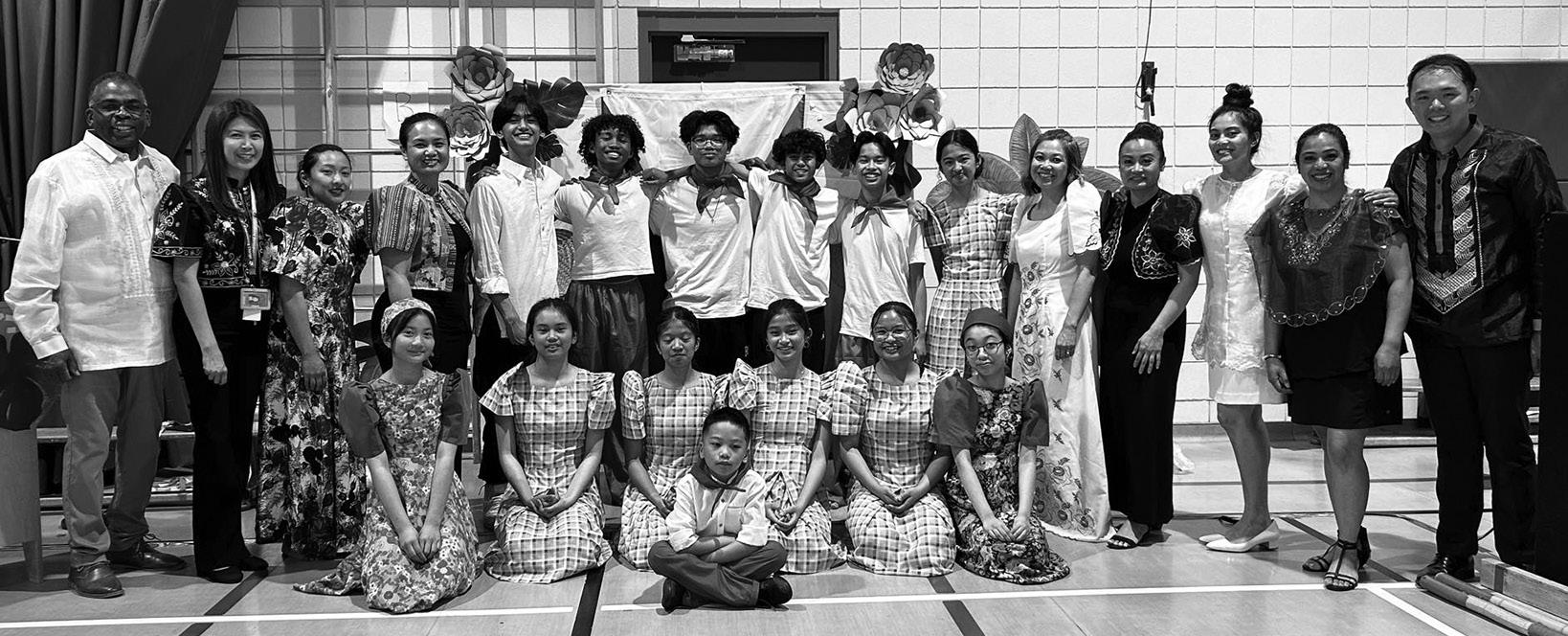
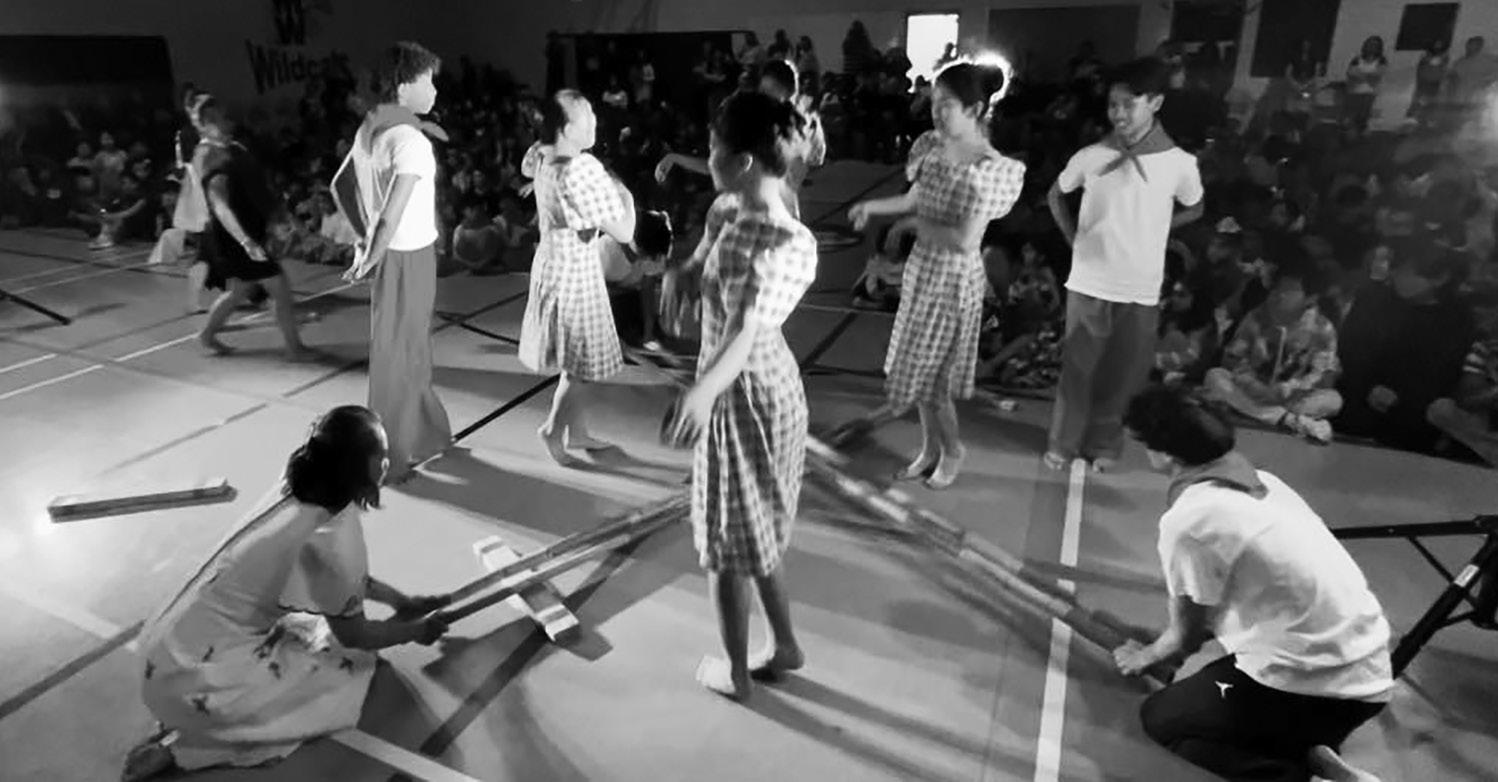
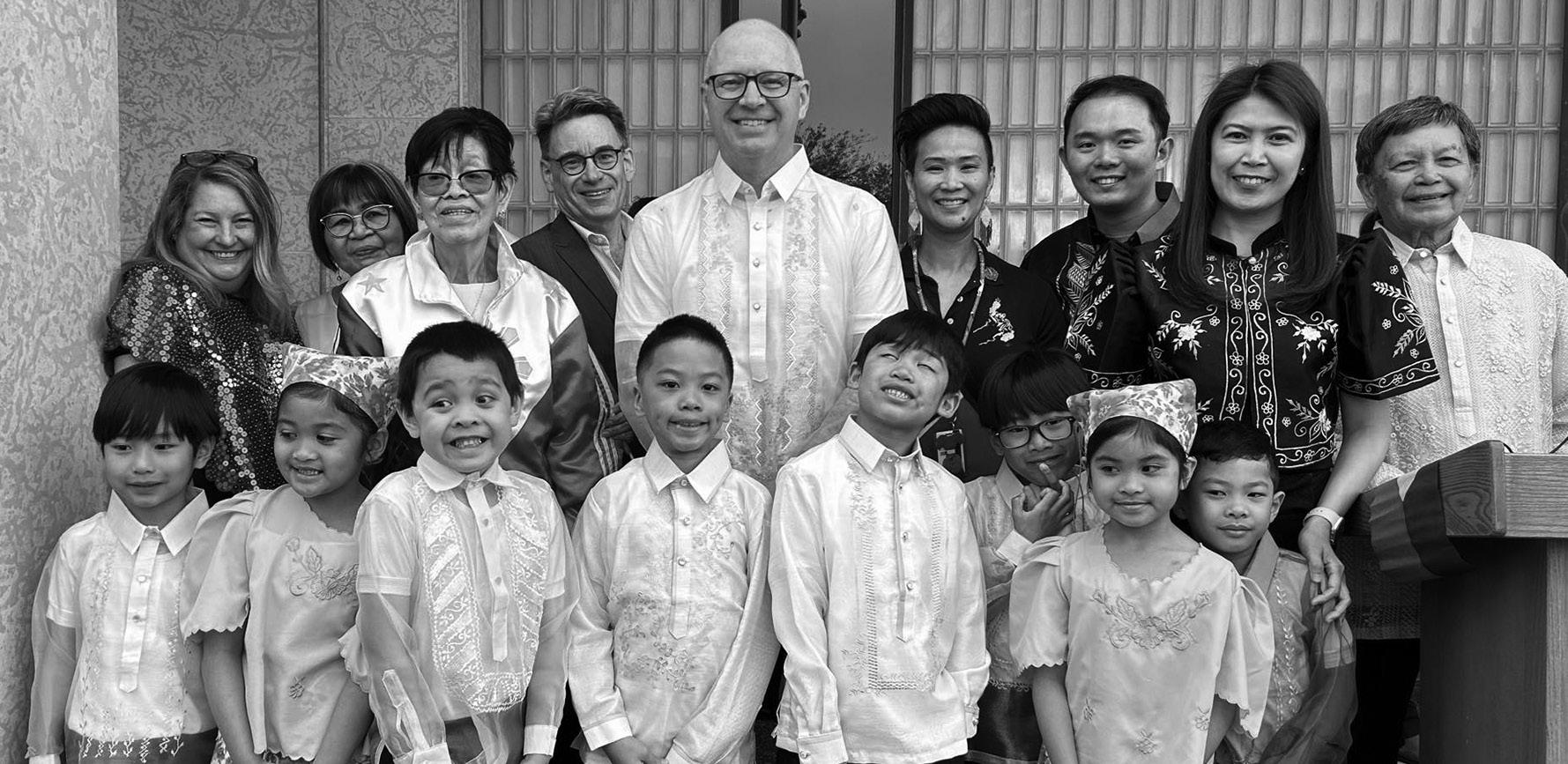
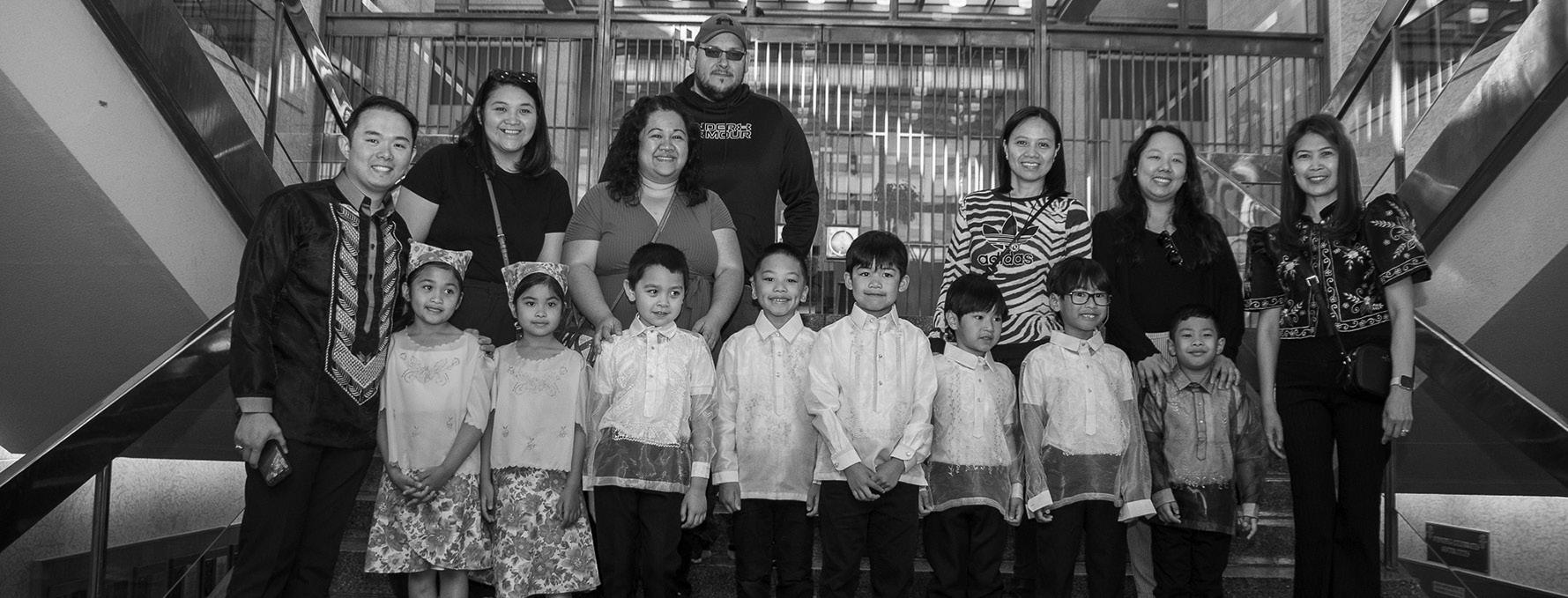


It has been a busy past few weeks for the various cultural programs of the Manitoba Association of Filipino Teachers, Inc. (MAFTI). A major component of MAFTI’s service to the community is its After School Heritage program. This class, taught by a range of talented teachers, introduces students of various backgrounds to Filipino language, culture, and arts. In addition, there were several Adult and Teen Filipino language classes. This year, MAFTI unveiled its Performing Arts group made up of students from all After-Class groups. Every year in June, students in every class showcase what they have learned during their class
This year’s performances kicked off on May 25 at Dufferin School for the Learning Culture Together event, which saw the Performing Arts group offer a song and dance presentation. Then, from May 30 to June 8, the AfterSchool program hosted the Pista sa MAFTI, held at Lord Nelson
School, Chalmers Neighbourhood Renewal Corp., Keewatin Prairie Community School, and Sargent Park School. The Adult and Teen language classes held their culminating activities on June 8 at Kalesa Corner. The Performing Arts group also participated in the flag raising ceremony at Save-onFood (McPhillips) on June 8 and have also been invited to perform at the Red River Ex on June 23.
Don’t miss this!
Without fail, these events continue to inspire year after year.
Driven by the passion, skill, and care of all teachers involved, a mix of new and returning students – many not of Filipino heritage – expand their horizons through creative outputs such as artwork, song and poetry performances, and dance. Each event this year was attended by parents as well as political and business leaders.
The presence of Matt Henderson, Superintendent for the Winnipeg School Division, was a sign of how much the programs are valued by the division. At a
MAFTI busy with culminating activities
conference held by the Philippine Association of Manitoba in 1977, great concern was expressed about the fate of Filipino culture in Manitoba and whether the language, values, and practices would continue in the province. Those present at this conference – many who continue to be active in the community today –would hopefully be proud to see the extent to which the Filipino Canadian youth of today seek to explore, learn, and preserve this culture. Certainly, Canada is better for such endeavours.
These classes not only inspire students to have a sense of appreciation and pride for Filipino culture and language, but also invoke sentiments of patriotism in those present. Each student demonstrated great courage and skill, getting up in front of friends, families, and dignitaries. On stage, they showed everyone what they were made and how, together, we can celebrate both Filipino culture and the land of Canada as a welcoming blend of many peoples. The children continue to inspire their teachers, and indeed all of MAFTI. The program continues to grow year by year and is, as always, free to enrol. For those you are interested, you may contact mafti.educators@
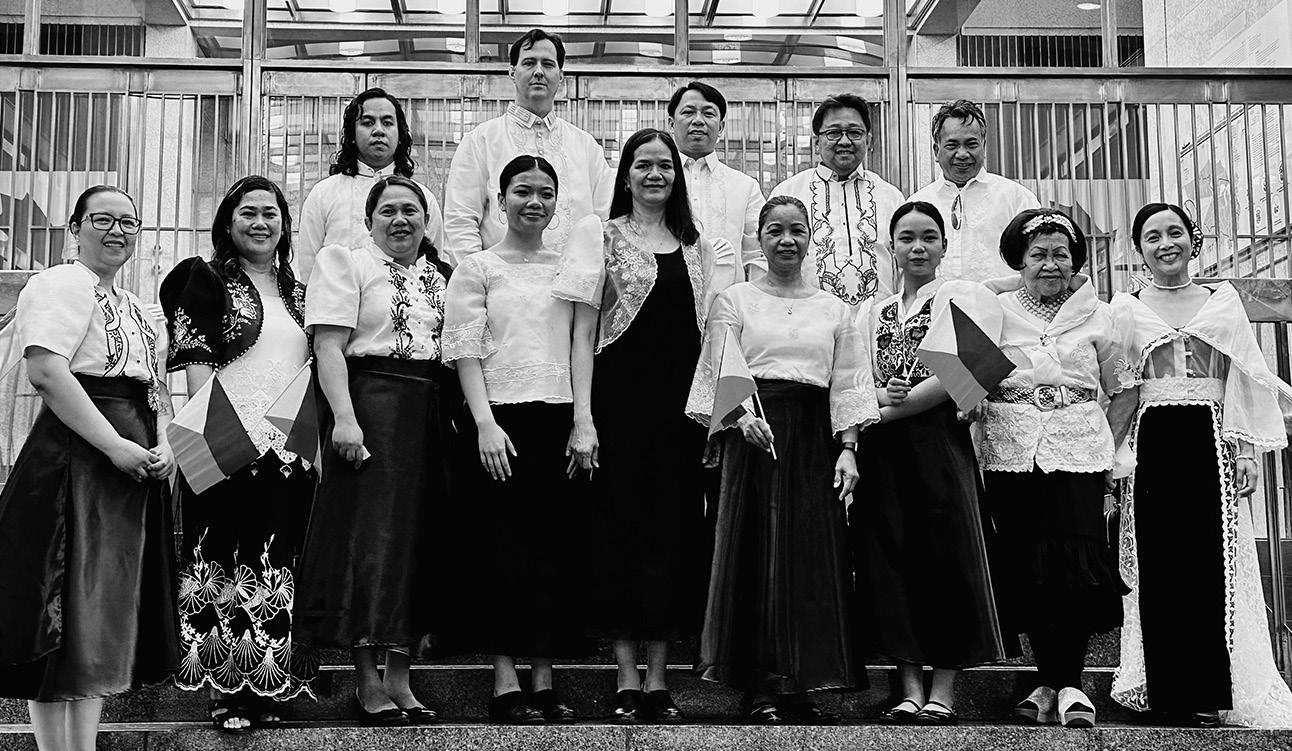

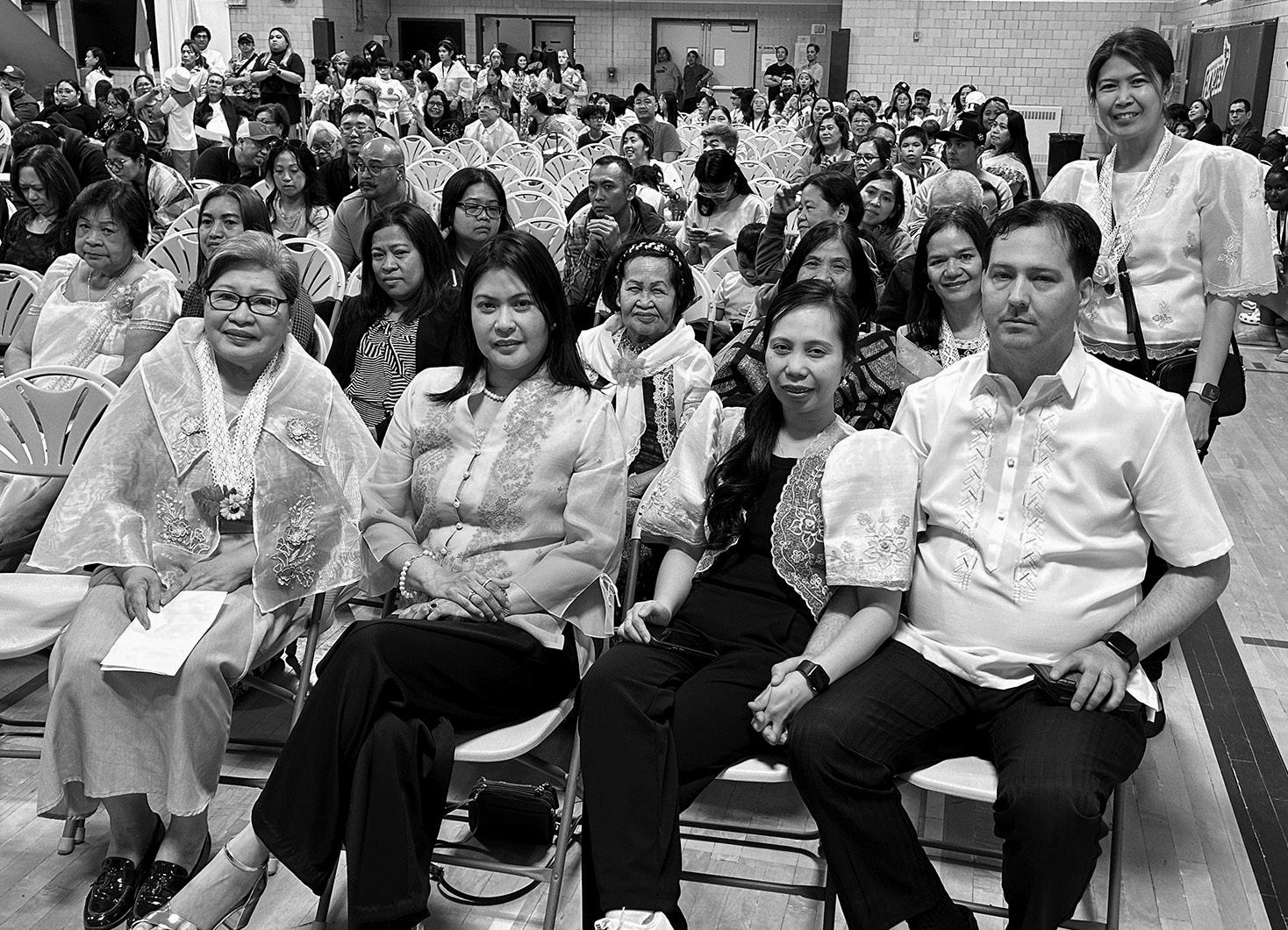
gmail.com for the next round of enrolment.
Mabuhay ang MAFTI at pagbati sa lahat ng mga estudyante! May and June also saw the first performances of MAFTI’s reinvigorated Rondalla group. First established by Linda Cantiveros many years ago, Genalyn Tan – former MAFTI president – has worked to revive the Rondalla along with Mervin Sison. Mervin is also releasing his adaptation of Noli Me Tangere on June 19th at the PCCM for free. Please, everyone attend! It will be memorable experience and a triumph for Teatro Filipino Manitoba. MAFTI wants to recognize the hard efforts of Mark Heramiz who led the Rondalla for the early growth and maturing of the performers and who has recently had to bid farewell as he moves on to Calgary. Mark’s leadership and inspiration was celebrated by the Rondalla group in a going-away party on June 8th at Jeepney restaurant. The bittersweetness of Mark’s departure, though, has meant the Rondalla has been blessed to be introduced to Mel Agravante, a very talented Filipino jazz musician. The Rondalla has been furnished with brand new instruments from the Philippines,
including the banduria, laud, octavina, and acoustic bass guitar. The Rondalla’s first performance was at the Manitoba Legislature on May 30, and its second at City Hall in celebration of Philippine Independence Day on June 12. The group continues to practice hard for its culminating concert in November. Dates and location to be announced. It, too, is free so please watch social media for more announcements!
This is a golden age of Filipino activity in Manitoba. The community continues to grow, with new Filipino businesses opening and thriving, and an increasing number of cultural presentations and activities being offered to members of the community. If you are intrigued by these, and would like to know more, you can reach out to me (Jon.Malek@prov.ca) and I’d be more than pleased to put you in touch with the right groups!
Jon Malek is an Assistant Professor of History at Providence University College. His research is on the history of the Philippines and the Filipino diaspora. His current writing projects include a book on the history of Filipinos in Canada and a project on Filipino food and culture.
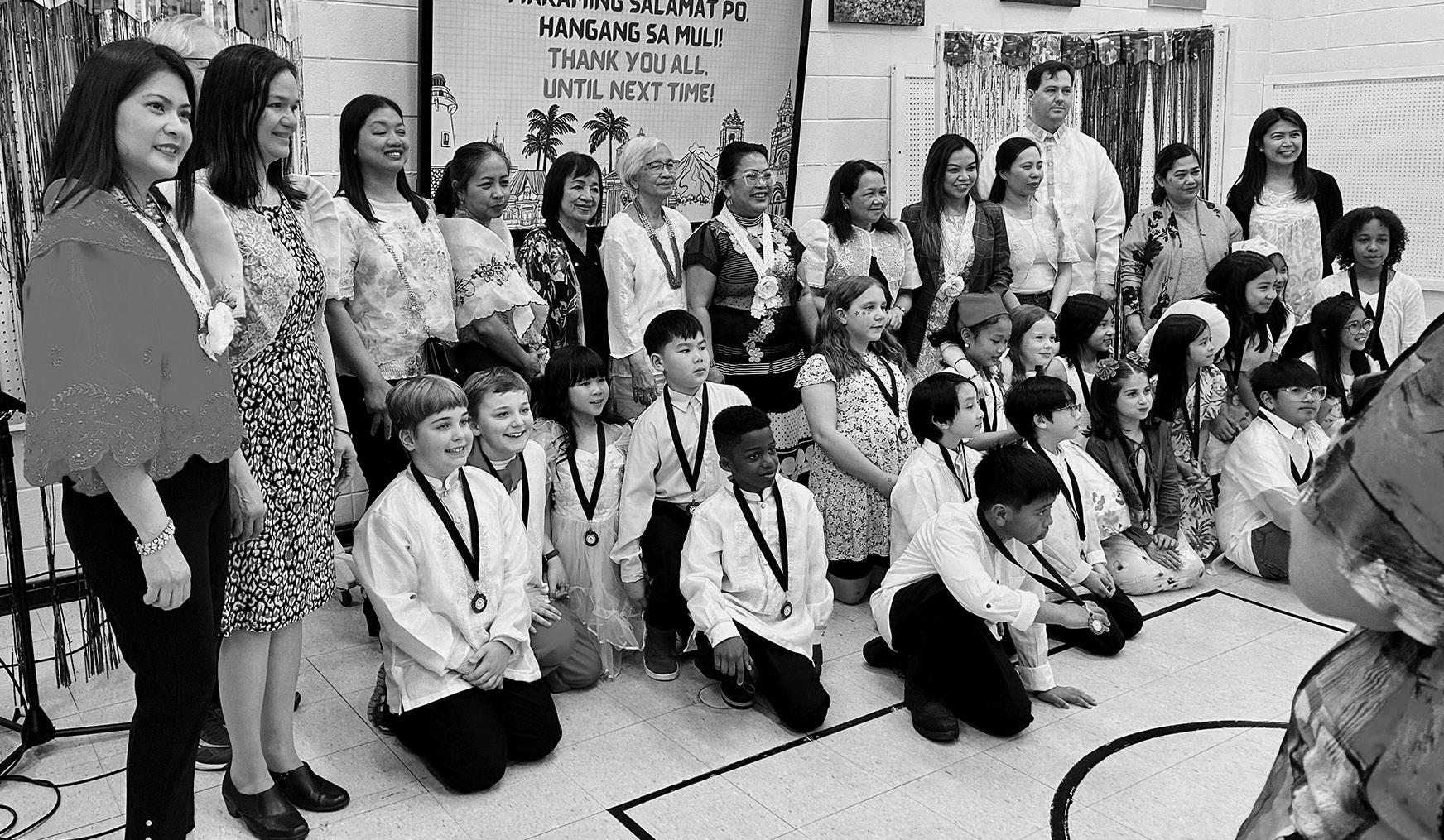
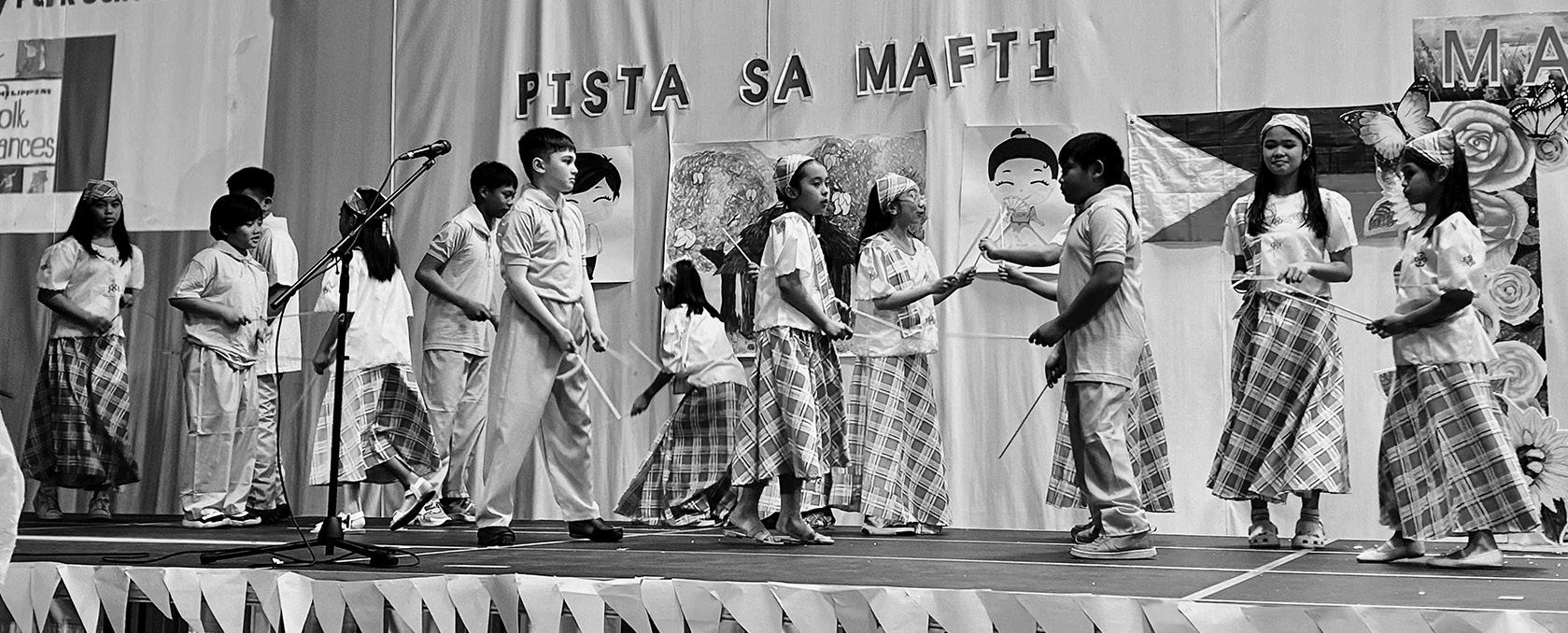
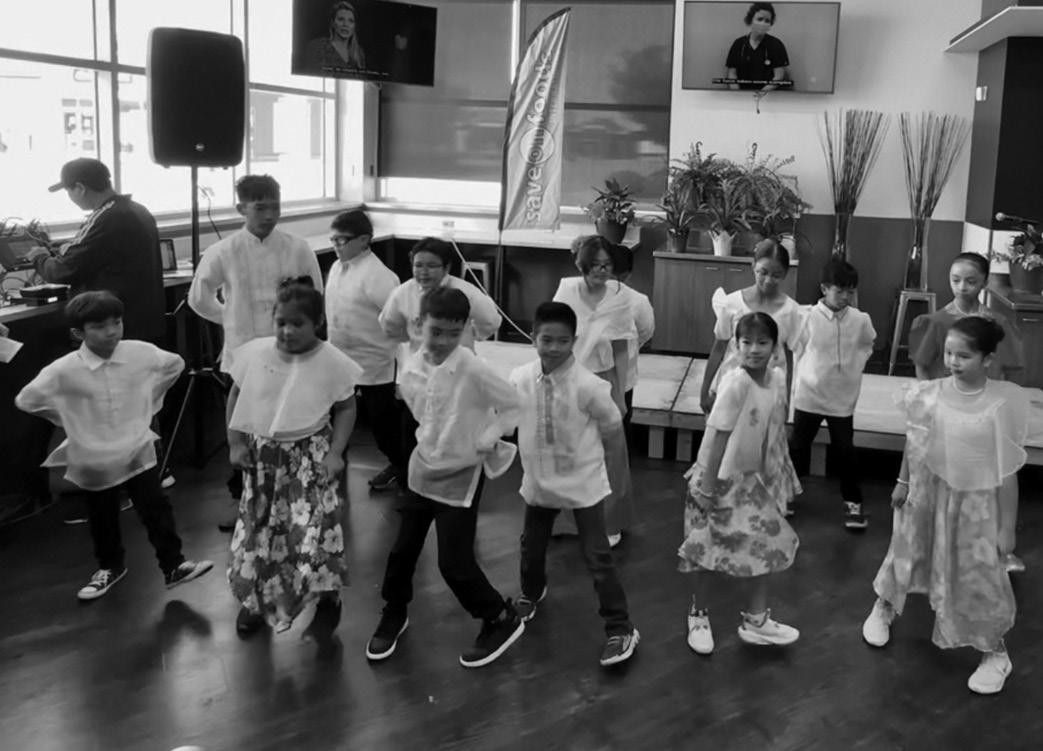
IVANA...
From page 8
may ginagawa ako sa public.”
“Kasi kapag nagba-vlog ako sa street, wala akong kasama. ‘Yung hairstylist ko lang pero malayo siya,” she revealed.
In Batang Quiapo, Alawi plays Bubbles. While vlogging is her top priority, she also enjoys portraying characters.
“It’s such a dream come true. Nagagawa ko ‘yung iba’t ibang acting like sa action scenes, sa drama. Ang ganda niya,” she said.
“Kasi sa content, I’m myself, I do it at my own time. Itong taping naman, MWF, tapos pagpasok mo dapat andoon ka na agad sa character mo,” she shared.
She went on to praise Batang Quiapo star Coco Martin: “Si Coco sobrang bait in everything, in action scenes, drama scenes.
Kapag hindi ko nagagawa, kakausapin niya ako na ganito ang mas magandang delivery.”
“Very hands on si Coco, the directors, and the whole staff ng Batang Quiapo.”
ABS-CBN News, Text and photos by Josh Mercado
ARNOLD...
From page 8
magmaneho pababa mula sa Antipolo.
Sa Fatima University Medical Center nagtungo si Igan at kaagad na sinuri.
“Lumitaw na ang blood pressure (BP) ko ay nasa 220/120 at ang blood sugar ko ay umabot ng 270,” kuwento niya.
Nang ipa-CT Scan siya, lumitaw na may “slight bleeding” umano sa kaliwang bahagi ng kaniyang utak.
“At sa oras na ‘yon, ako ay nagkaroon na ng ‘hemorrhagic stroke’!” saad niya.
Ayon kay Arnold, inilipat siya sa St. Lukes Hospital sa Metro Manila para lalo pang maobserbahan.
SHOWBIZ SHOWBUZZ
dinala sa Acute Stroke Unit ng ospital para ganap na bantayan ang aking BP at sugar,” sabi niya.
Sa post, inihayag ni Arnold ang pasasalamat sa tinawag niyang “miracle” sa kaniyang buhay.
“Thank you Lord. I personally experienced your miracle,” ayon kay Arnold.
Ibinahagi rin niya ang aral na kaniyang natutunan sa naging karanasan.
“ARAL: Feeling OK does not mean your OK. Feeling good does not mean we’re good. Listen to your body. Traydor ang hypertension! Always check your BP,” paalala niya.
— FRJ, GMA Integrated News
ARAW...
From page 8
“Agad akong inasikaso sa ER ng kanilang brain attack team at challenges.
Pulang Araw captures the country’s rich history that built the identity and gave freedom to every Filipino. Indeed, the program celebrates independence and heroism. As part of the celebration, GMA Network gave viewers a sneak peek at the gritty drama set during World War II.
The show’s trailer was unveiled on June 10 after 24 Oras, which instantly drew clamour and excitement from Kapuso fans. See the powerhouse ensemble, world-class production, and extraordinary visuals of Pulang Araw, coming to Netflix on July 26 and on GMA Prime beginning July 29.

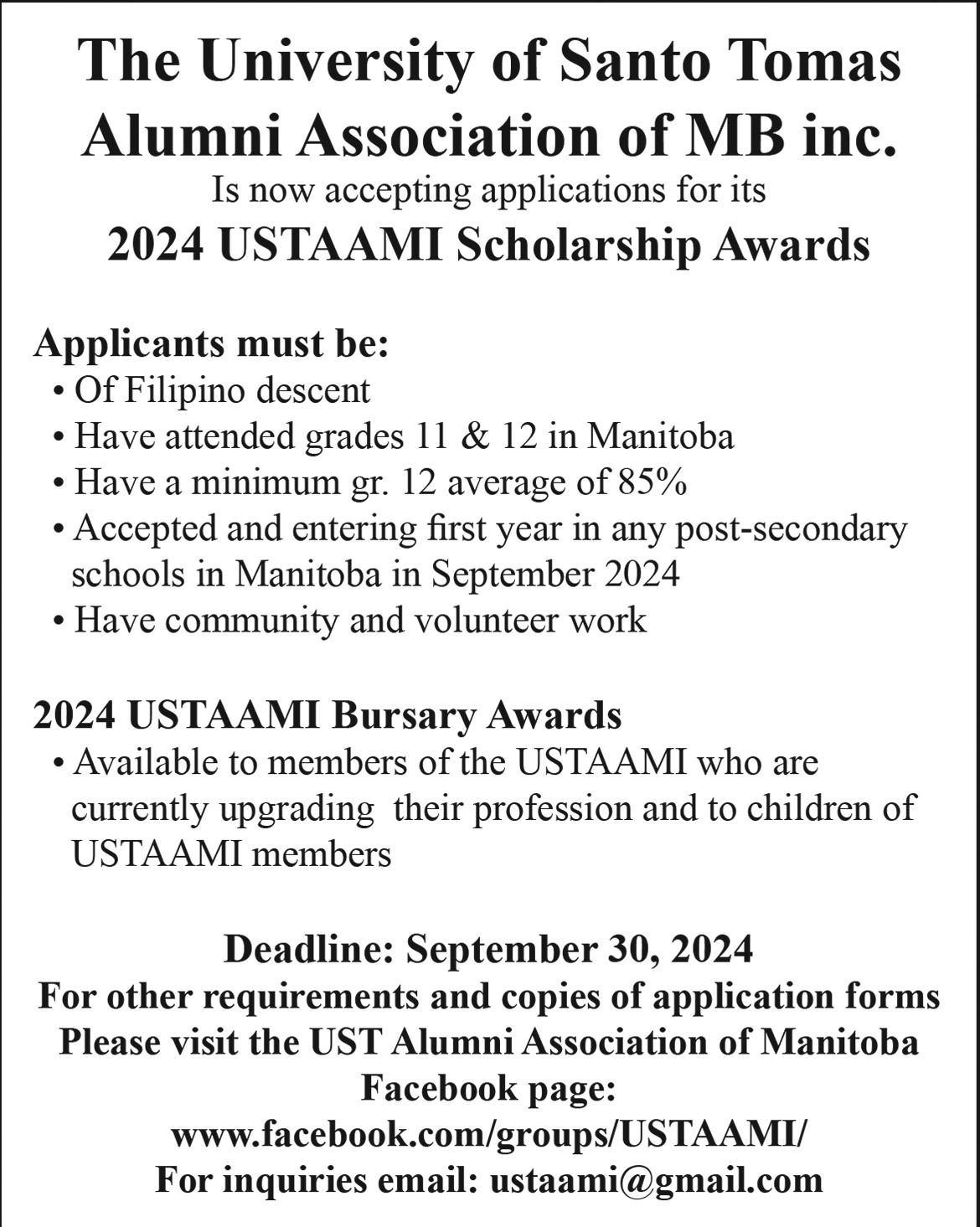
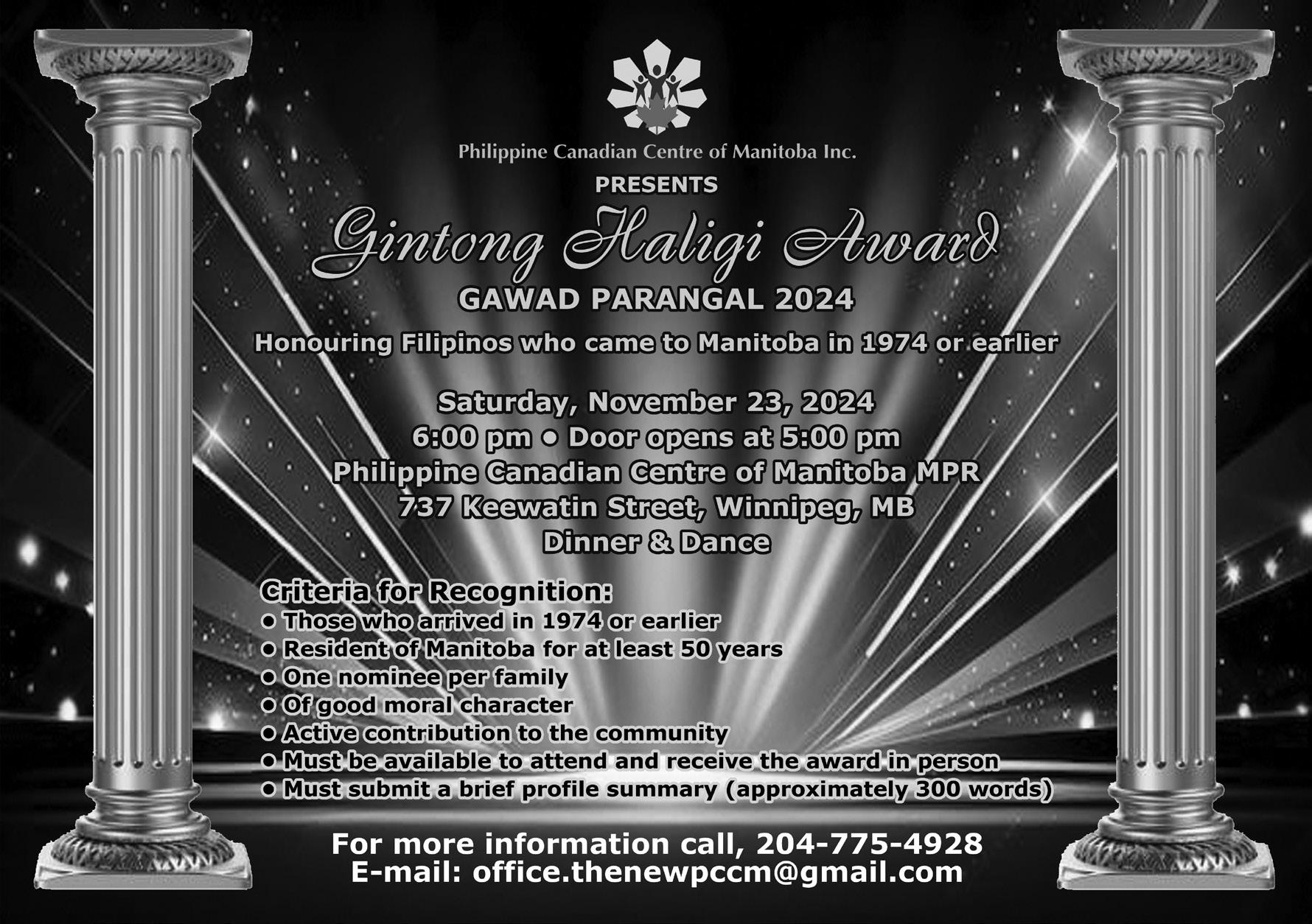


EH KASI, PINOY!
NO. 443
Ni Bro. Gerry Gamurot

Walang bayad
Imbakan ng tubig
Tarok
Angkan
Bahay-ampunan
Tauhan
Marahil
SAGOT SA NO. 442


“They deserve love, to love, and be loved”by Maryrose Villena ACC News Correspondent
To jumpstart pride month this June, Bahaghari Pride Manitoba Inc. organized a photoshoot called “Sama-Sama” a Bahaghari Portrait series last May 24th at the Forks Market. All members of the 2SLGBTQIA+ community in Manitoba were invited to get their portraits taken solo, with partners, or friends to celebrate and help embrace their identity.
Bahaghari is non-profit and was just newly established last February. Founder, Dieth Aquino de Leon wanted this event to become a safe space for his fellow Filipinos who are part of the community. Fellow local queer photographer Ally Gonzalo –known for his work of Bakla! for CBC – teamed up with Dieth for



this whole-day portrait session as a way for their fellow Bahaghari members to eliminate the shame, highlight who they are, and show that they belong.
In Manitoba there is a considerable number of Filipinos who identify and are part of the 2SLGBTQIA+ spectrum according to Dieth. He fought to be able to have this organization and built it from the ground by speaking to various council members to have proper support.
Furthermore, it is only in North America that 2S (two-spirited) is included in the spectrum.
An indigenous term for Native Americans wherein both genders (male and female) are embodied in one individual as spiritual identity.
In the heart of this event, Dieth Aquino saw the fruits of
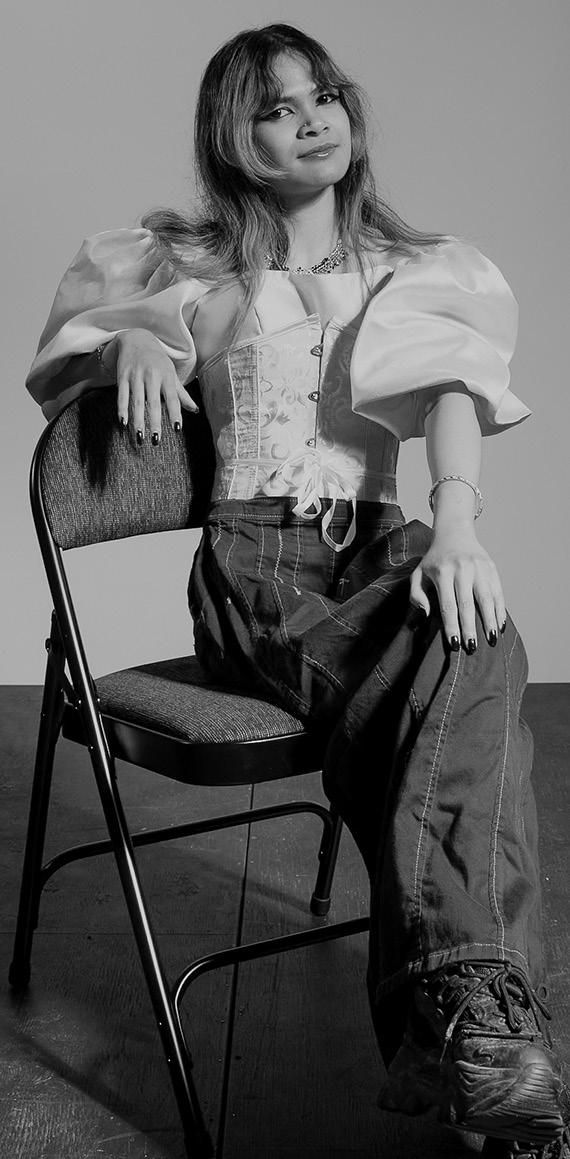
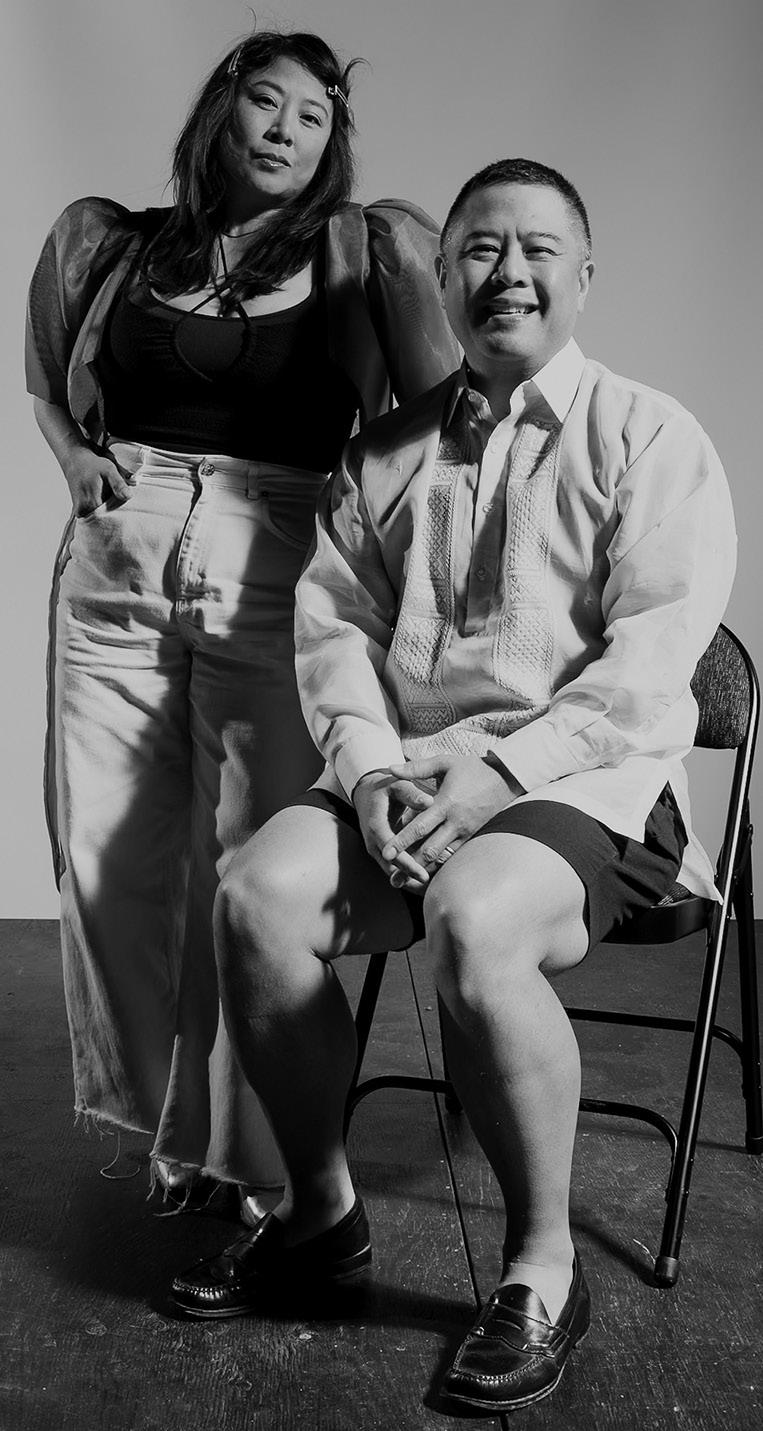

his hard work in establishing Bahaghari starting to bloom. People, mostly Filipino, and diverse personalities came to get their photos done. There were families, partners, even cisgenders and allies who came to support their friends during the session. Ally also made sure to make them feel comfortable in their skin by thoroughly directing them the whole time. The shoot enabled them to have a stronger grasp of their identity.
“We need to represent, and have every letter represented.” according to Chloe, a fellow member of the community said. For there has been so much war going on that violence to be heard and to be seen is over– it is time for them to be celebrated.
For they deserve love, to love, and be loved.

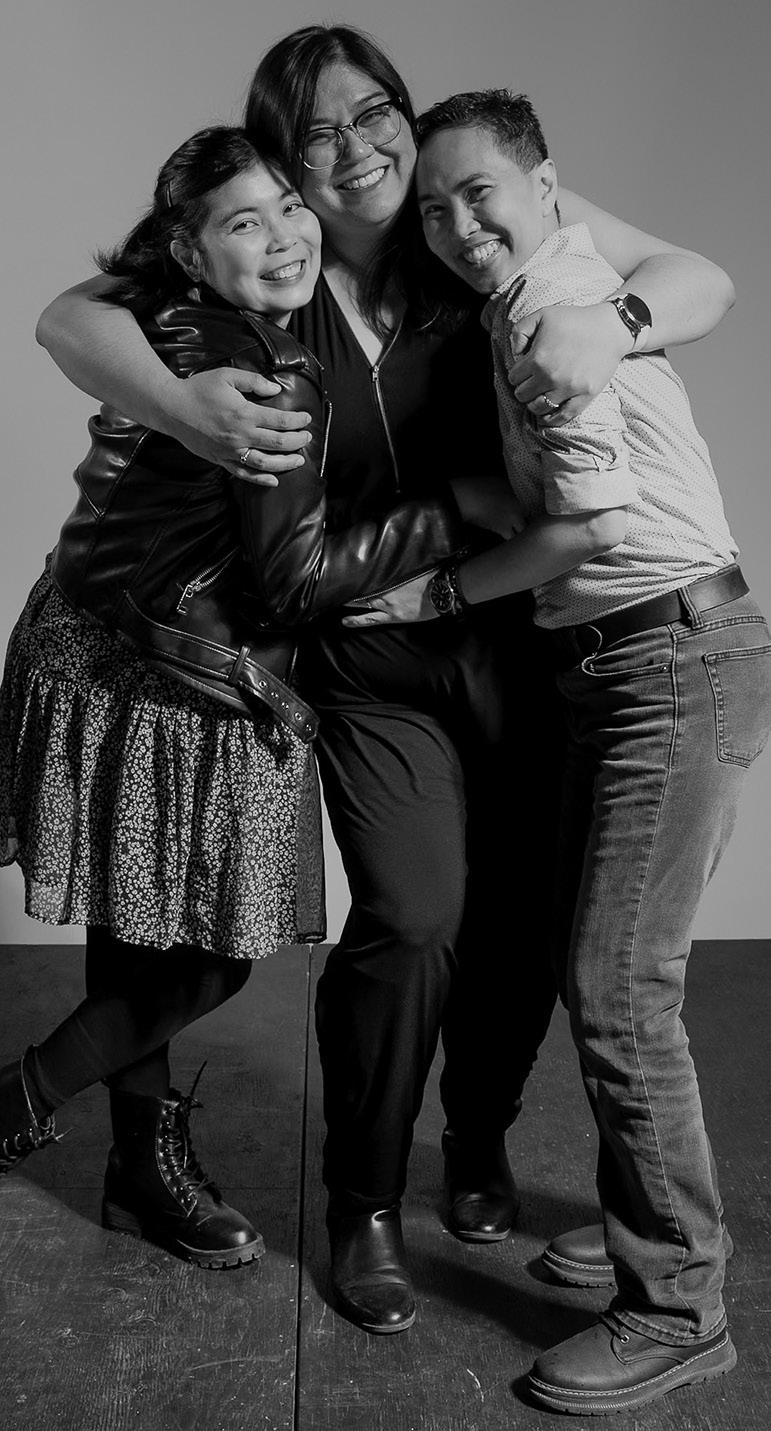

HERITAGE...
From page 1
Canadians have made their mark in various fields including politics, sports, the arts, finance, and social justice,” said Canadian Heritage Minister Kamal Khera on Filipino Heritage Month.
The Philippine Heritage Council of Manitoba (PHCM), led by President Perla Javate and in partnership with the Knights of Rizal, continues its cultural celebration with a Reading of Noli Me Tangere on June 19 at the PCCM. The annual Philippine
PEOPLE & EVENTS
Independence Ball will follow on June 22 at the Victoria Inn. On June 26, a Sharing Circle will be held at the PCCM. The month-long celebration will conclude with a newcomers’ picnic at Assiniboine Park, featuring multicultural music, arts presentations, and Filipino food. This year’s PHCM theme is Bayanihan…Pamana Sa Kabataan. “Community Spirit, our legacy for our youth.”
Photos by Rey-Ar Reyes taken at the inaugural Filipino Heritage Month Kick Off at the Legislative Building, June 1, 2024.

